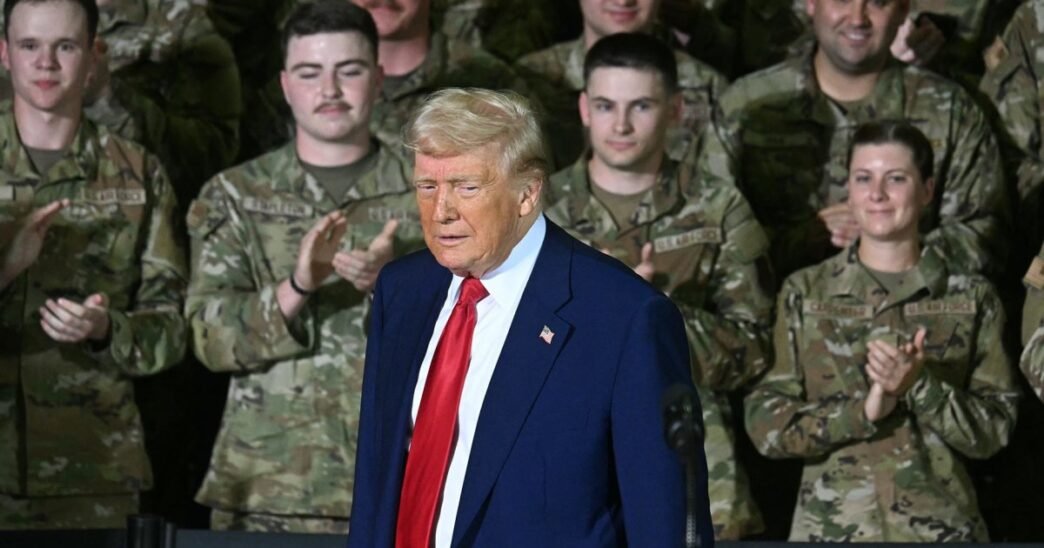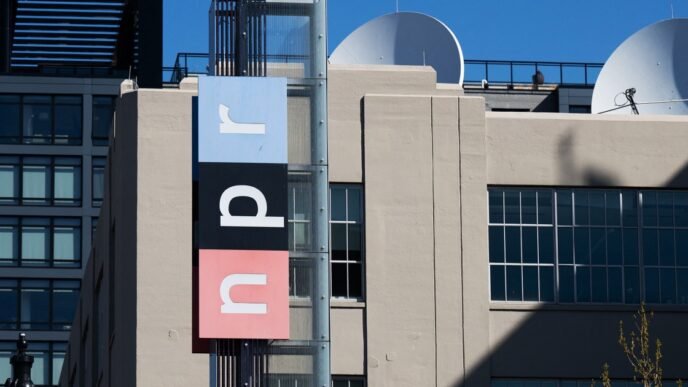Donald Trump has historically bad poll numbers for a president through the first 100 days in office, but the White House’s 2026 midterms strategy will run through Trump himself while trying to re-create the energy behind his 2024 campaign.
Republicans and top White House advisers generally believe the midterm maps are favorable to them in the Senate but more up in the air on the House side. But Trump’s lagging poll numbers — and what has become an unpopular, tariff-dominated economic policy, at least for now — have some Republicans concerned that both chambers could be at risk.
The 2026 goal, according to nearly a dozen Republican operatives and Trump advisers NBC News interviewed, is to try to overcome negative economic sentiment by rekindling the energy Trump brings when he is on the ballot — a needed boost for the party after Democrats have outpaced Republicans in recent special congressional and state-level elections.
House and Senate leaders are already in close consultation with the White House about key candidates who would benefit from Trump’s endorsement, both to navigate primaries and to gin up general election support. His political operation is banking millions of dollars in explicitly Trump-aligned political groups that will play heavily in the midterms alongside Republicans’ party committees and principal congressional super PACs. And then, top Republicans expect the rest of the party to lean into Trump’s message to make the best possible pitch to his supporters to vote in 2026.
“The push needs to be to push that energy. In some states his endorsement will be very beneficial, and it’s up to candidates to try and replicate his messaging to spur turnout,” said Rachel Reisner, a longtime Republican operative who worked for Trump’s 2024 campaign.
Reisner added that some of the most intense Trump voters who support him in presidential election cycles do not always show up in nonpresidential races, something that has been amplified in recent special elections, most notably a Supreme Court race in Wisconsin, where Democrats overperformed compared with the political makeup of the districts in play. She said getting those voters to get engaged as though Trump is on the ballot will be a key push for Republicans next year.
“We clearly know a motivated, angry liberal is likely to turn out to vote,” Reisner said. “We can’t get too full of ourselves or think we have the perfect messaging. There are some center-right voters who voted for President Trump who said, ‘Of course we will win,’ but we need to make sure those people turn out.”
Shaping the issues and the candidates on the field
Much of the dynamic as the midterm election takes shape will be about immigration policy versus economic policy.
Trump’s handling of immigration, which has led to a significant reduction of border crossings at the southern border, has generally gotten higher marks from voters, and the White House is eager to talk that up. But his decision to impose tariffs on most of the world has sent shock waves through the financial markets and has had political ripple effects that could erode Republican confidence if, as promised, the administration does not cut a series of trade deals in the very near future.
“The president’s economic policies have been disastrous with this tariff play, right?” said a longtime prominent Republican donor. “It’s disastrous. I think it does put the Senate in play. I mean, I think it puts a ton of pressure on the House.
“If they don’t announce some deals, and, I mean, like, in the next two weeks, I think they’re going to have real problems,” the person added.
Yet Republicans do have serious opportunities in the Senate, which Democrats could flip by netting four seats. Sen. Jon Ossoff, D-Ga., is a top target, and the GOP is trying to flip open seats held by retiring Democrats in Michigan, New Hampshire and Minnesota. Meanwhile, the only Republican senators who appear in danger are Maine’s Susan Collins and North Carolina’s Thom Tillis.
Before he won it last year, rgia had been a problem area for Trump, marked by Ossoff’s and Sen. Raphael Warnock’s runoff victories in Janu 2021 and a failed attempt to defeat GOP Gov. Brian Kemp in a prim.
But one Trump adviser, who was granted anonymity to speak candidly, said Trump would back Kemp if he were to challenge Ossoff, as Republican leaders would like, despite the past tension.
“No doubt, he would endorse Kemp,” the person said.
Trump plans to endorse in both Senate and House primaries ahead of the midterms, including “in competitive seats,” the White House adviser said, with special attention on how incumbents vote on Trump’s legislative priorities this year.
So far, there has been some delay between Senate GOP leaders’ endorsements in key races and Trump’s chiming in. Both Tim Scott, of South Carolina, the chair of the National Republican Senatorial Committee, and Majority Leader John Thune, of South Dakota, have backed former Rep. Mike Rogers’ Senate bid in Michigan while other Republicans consider running. They have also backed Sen. John Cornyn’s re-election run in Texas, where he will face a prim fight against state Attorney General Ken Paxton. Trump has not endorsed yet in either race.
The Trump adviser said his lack of immediate endorsement in those races should not be interpreted as a sign of distance between him and Senate GOP leaders, who talked to him before they made the early endorsements.
“I would tell you they would not be moving so aggressively without some directionality,” the adviser said. “The president is probably leaning towards Mike [Rogers].”
A person familiar with the NRSC’s thinking said no endorsement decisions are made without “making sure the White House is aware of what’s going on.”
There is some tension between the White House and Scott, who ran against Trump in 2023 before he dropped out of the GOP race and later endorsed him. Some of the heartburn comes from Scott’s trying to hire staff members perceived as having worked for groups that previously opposed Trump.
The Trump adviser did little to downplay the potential tension, offering a less-than-ringing endorsement for Scott’s leadership.
“I mean, he’s OK, I guess,” the person said.
Spokeswoman Joanna Rodriguez said the NRSC is on the same page with Trump.
“Republicans are working as one team with President Trump to deliver for the American people, protect and grow our Majority in 2026, and hold Senate Democrats and candidates accountable for their radical, out-of-touch priorities and dishonest fear-mongering,” she said in a statement.
Pouring pro-Trump money into the midterms
The White House does plan to deploy “our own resources” during the midterms through a series of super PACs and other vehicles, the White House adviser said, a signal that its political shop will run its own campaign strategy rather than just rely on party-aligned campaign organizations like the NRSC.
“I think [the White House] will be deploying significant resources on its own,” the adviser said. “Anyone looking for a big contribution will be disappointed. I think this will be protracted trench warfare, and we have the munitions.”
Republicans say the early midterm data is encouraging, despite Trump’s low personal polling numbers. Internal polling touted this week by the National Republican Congressional Committee found Democrats essentially tied with Republicans on a generic ballot offered to likely voters in competitive House districts. At this point in the 2018 midterm cycle, during Trump’s first administration, Democrats had a 6-point lead in that measure.
Several recent media polls have found Democrats with a slight edge in national generic ballot tests, within the margins of error. Much can also change in the year-plus before the midterm elections, but Republicans are hopeful the numbers hint at something closer to 2022, when Democrats performed better than expected in President Joe Biden’s lone midterm election (though they still narrowly lost the House).
“It’s a small map,” a House Republican strategist said. “If you look at 2024, there were 10 races that were won by 5,000 votes or less.”
A person close to the White House, who was granted anonymity to share internal thinking, noted that Trump’s polling numbers, while they are dipping, are better than they were in 2017. But this person also cautioned that outside factors — like an economic depression or escalating wars in the Middle East — could shift the trajectory.
Where to send Trump
Still, Trump remains a large draw, and this person said the biggest mistake Republicans could make would be to sideline him.
“They should want Trump anywhere and everywhere that he’s willing to go for the very simple fact that we now have empirical evidence that there’s a large group of voters who are not automatic Republican voters — they’re automatic Trump voters,” the source close to the White House said.
The House GOP strategist agreed.
“The whole end game in 2026 is to get these Trump voters out to vote again,” this person said. “It’s what we’re all trying to figure out — if we can get these presidential voters to come out and vote in the midterms. So the president is helpful. These are his voters, and we need to turn them out. And no one is better at turning out those voters than Donald J. Trump.”
Democrats need to net only three seats to flip the House, but Republicans can find hope in some of the House map battle lines. Democrats represent 13 House districts that Trump won last year, compared with only three Republicans in seats won by Kamala Harris, according to an analysis of election results by NBC News’ Decision Desk.
“This is a map where we can go on offense,” the Trump adviser said.
The person close to the White House who favors sending Trump anywhere he is willing to go was unsure how much he would want to campaign and envisioned a scenario in which Donald Trump Jr. and Vice President JD Vance would pitch in to headline rallies across the country. Vance, who is expected to run in 2028 to succeed the Trump, who is term-limited, could be boosted by a successful supporting role in the midterms. He is likely to be heavily deployed in key races, this person added.
“Between the president, the vice president and Don Jr., Republicans actually have three surrogates that can drive serious earned media anywhere they go and draw big crowds anywhere they go. Is there anyone the Democrats have that compares to that?” this person said.
Republicans also see a favorable Senate map — “just in terms of the open seats and where they are,” said Greg Manz, a Michigan-based GOP strategist who was an adviser to Trump’s 2020 campaign.
Manz saw Trump’s visit this week to Macomb County, Michigan — a swingy slice of Detroit suburbs long known for its “Reagan Democrats” — as foreshadowing for an intense focus on the state.
Trump announced new fighter jets for an endangered Air National Guard base and presided over a bipartisan event that included Gov. Gretchen Whitmer, a Democrat who could be a candidate for president in 2028, and Rep. John James, a Republican running to succeed Whitmer, who is term-limited, next year.
Michigan’s races for governor, an open U.S. Senate seat and several competitive U.S. House seats, including James’ in Macomb County, will be among the key races in the country.
“As much time as we can get him in Macomb, it will be key,” Manz said, also name-dropping Pennsylvania and New York as places with important House races where Republicans believe Trump is uniquely capable of turning out GOP votes.
There is some concern that if Democrats take the House, they could move to impeach Trump for a third time, which his political operation already has in mind. In fact, it wants to keep that notion in the headlines as a way to remind Republican voters of the stakes of the 2026 midterms.
The Trump adviser dismissed the notion of Democrats’ winning the House, despite how close the margins are. “But,” the adviser said, “this is about making sure voters remember the stakes of the midterm elections.”













